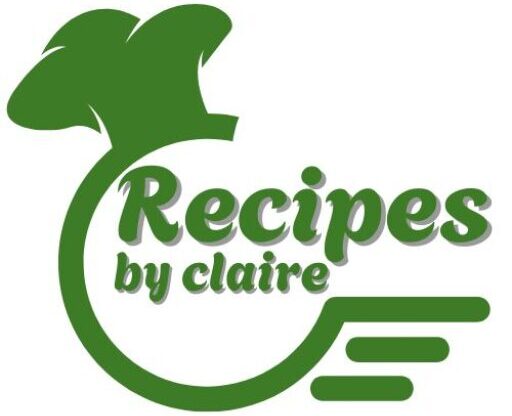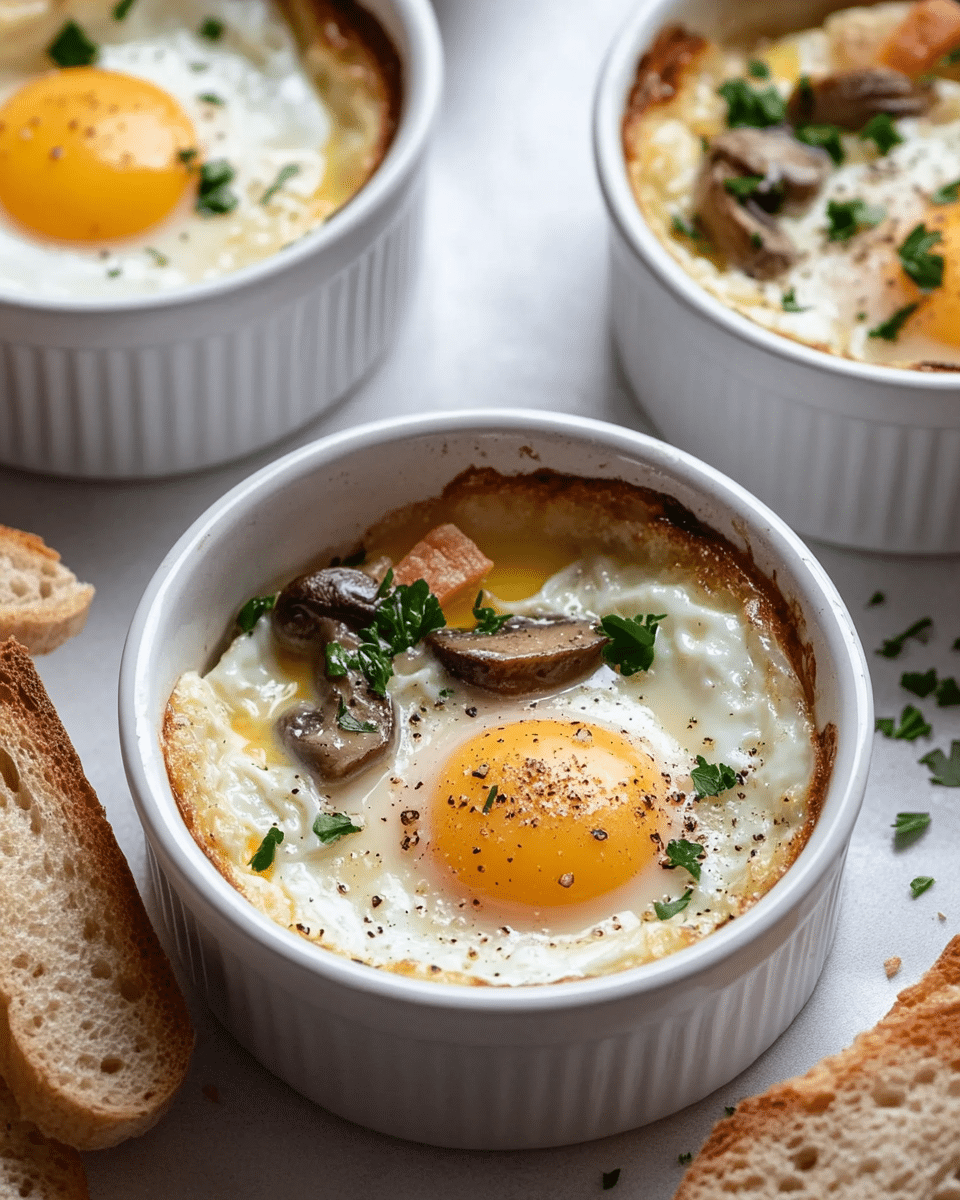The French dish “Eggs en Cocotte” is a beautifully simple yet luxurious breakfast or brunch option. Known for its rich texture and aromatic appeal, this recipe involves baking eggs gently in ramekins with cream, herbs, and flavorful sautéed mushrooms. The steam created from a water bath ensures the perfect soft yolk while preserving the delicate nature of the egg whites. This dish is effortlessly elegant and endlessly customizable swap out the mushrooms for spinach, ham, or smoked salmon, or finish with cheese or truffle oil for added richness. It’s a meal that looks and tastes like something served at a Parisian café, but comes together easily in your home kitchen. Serve it with toast points or crusty bread, and you have a bistro-worthy plate to start your day with style.
Full Recipe:
Ingredients:
-
4 large eggs
-
1 tablespoon unsalted butter (plus more for greasing)
-
½ cup heavy cream
-
1 cup cremini mushrooms, finely chopped
-
1 small shallot, minced
-
1 tablespoon fresh thyme leaves
-
Salt and black pepper to taste
-
Fresh parsley, chopped (for garnish)
-
Toasted sourdough or baguette, for serving
Directions:
-
Preheat your oven to 375°F (190°C). Lightly butter four small ramekins and place them in a deep baking dish.
-
In a skillet over medium heat, melt 1 tablespoon butter. Add shallots and mushrooms; sauté for 4-5 minutes until golden and tender. Stir in thyme and season with salt and pepper.
-
Divide the mushroom mixture evenly into the ramekins.
-
Crack one egg into each ramekin over the mushrooms. Pour 2 tablespoons of heavy cream into each dish.
-
Place the baking dish on the oven rack, then carefully pour hot water into the baking dish to reach halfway up the sides of the ramekins.
-
Bake for 12-15 minutes, or until the egg whites are just set and the yolks are still slightly runny.
-
Carefully remove ramekins from the water bath. Garnish with parsley and serve immediately with toasted bread.
Prep Time: 10 minutes | Cooking Time: 15 minutes | Total Time: 25 minutes
Kcal: 265 kcal | Servings: 4 servings
Discover the Charm of Eggs en Cocotte: A French Classic Brought Home
When it comes to elegant yet simple breakfast dishes, few recipes rival the sophistication and comfort of Eggs en Cocotte. This classic French preparation, often reserved for leisurely weekend brunches or intimate breakfasts, encapsulates everything that makes French cuisine so admired minimal ingredients, careful technique, and flavor elevated through simplicity.
Eggs en Cocotte, also known as “baked eggs,” are gently cooked in ramekins within a water bath, often accompanied by a rich component like cream, butter, cheese, or savory vegetables such as mushrooms or spinach. The result is a tender, creamy, and luxurious egg dish with soft yolks and just-set whites that pair perfectly with a slice of crusty sourdough or baguette.
Let’s explore why this timeless dish remains a favorite in home kitchens and high-end brunch menus alike.
The Origin and Meaning of Eggs en Cocotte
“Cocotte” in French refers to a small baking dish or ramekin, and “Eggs en Cocotte” literally means “eggs in a small pot.” This method of cooking dates back centuries, rooted in the tradition of preparing eggs delicately to preserve their texture and flavor.
Unlike fried or poached eggs that demand high heat and attention, eggs en cocotte embrace a gentler process often baked in a bain-marie (water bath) ensuring even, consistent cooking. This technique showcases the essence of French culinary wisdom: respect for ingredients and controlled heat to coax out the best from every element.
It’s a dish often served in upscale cafés and hotels in France but can easily be recreated at home with minimal tools and ingredients.
Why Eggs en Cocotte Deserve a Spot in Your Breakfast Rotation
Eggs en Cocotte offer more than just visual appeal and French flair. Here are a few reasons why this dish should become a staple in your culinary repertoire:
1. Effortless Elegance
Few recipes look this sophisticated with such little effort. Served in individual ramekins, the dish feels luxurious and personal, making it perfect for hosting guests or treating yourself to a special morning meal.
2. Versatile Flavor Profiles
While mushrooms, cream, and herbs are a classic combination, the beauty of this dish lies in its versatility. You can add sautéed spinach, ham, smoked salmon, caramelized onions, or grated cheese. You can even introduce spice with chili oil or harissa for a modern twist.
3. Perfect Texture Every Time
Cooking the eggs in a water bath helps control the heat, resulting in a uniformly cooked dish. The egg whites become silky and set, while the yolks remain runny and rich ideal for dipping toast.
4. Nutritional Balance
Eggs are a nutritional powerhouse high in protein, essential vitamins, and healthy fats. Add in mushrooms or other vegetables, and the dish becomes both hearty and healthy. Pair it with a slice of whole grain bread or a light salad, and you’ve got a well-rounded meal.
Technique and Equipment: Simple Tools, Big Flavor
You don’t need a commercial kitchen or specialized tools to make Eggs en Cocotte. A set of small ramekins and a deep baking dish for the water bath are the only essentials. Preheating the oven, preparing your ingredients, and carefully placing the ramekins in the hot water ensures the cooking is controlled and the eggs remain delicate.
The key here is not to overbake cooking for just 12–15 minutes is usually sufficient. The eggs should jiggle slightly when removed from the oven, as they will continue cooking from residual heat.
Garnishing with chopped parsley, chives, or even truffle oil right before serving elevates the presentation and enhances the flavors.
Serving Suggestions and Pairings
Eggs en Cocotte are most often enjoyed with slices of toasted bread sourdough, baguette, or even brioche. The richness of the eggs and cream begs to be scooped up with something crisp and golden.
To balance the richness, consider serving alongside:
-
A lightly dressed arugula salad with lemon vinaigrette
-
Roasted cherry tomatoes
-
Grilled asparagus spears
-
Fresh fruit and a drizzle of honey
For beverages, coffee is a natural pairing, though a mimosa or freshly squeezed orange juice brings a touch of brunch celebration to the meal.
Customizing the Dish for Dietary Preferences
One of the most appealing aspects of Eggs en Cocotte is how adaptable they are:
-
Low-Carb / Keto: Skip the toast and pair with roasted vegetables or avocado slices.
-
Vegetarian: Use mushrooms, spinach, leeks, or sun-dried tomatoes as the base.
-
Dairy-Free: Substitute cream with coconut milk or a dairy-free alternative.
-
High-Protein: Add diced ham, turkey, or smoked salmon for an extra protein boost.
Whether you follow a particular dietary style or just want variety, this dish offers countless opportunities to mix things up while retaining the essential technique.
French Flair Meets Modern Brunch Culture
Eggs en Cocotte have gained popularity in recent years thanks to their Instagram-worthy presentation and effortless luxury. They’re featured in trendy cafés, social media feeds, and breakfast boards because they photograph beautifully and deliver exceptional flavor with minimal ingredients.
Unlike dishes that require flamboyant plating or dozens of components, this recipe feels grounded yet gourmet. It appeals to minimalist cooks and seasoned chefs alike.
Moreover, as more people seek out ways to elevate their at-home dining experiences, this dish fits the bill perfectly. It shows that with care and technique, even a simple egg can be transformed into something extraordinary.
Conclusion:
In a world filled with fast breakfasts and grab-and-go meals, Eggs en Cocotte invite us to slow down and savor the moment. With a handful of simple ingredients and a bit of gentle cooking, this French classic brings elegance and comfort together in one ramekin.
Whether you’re planning a brunch party, impressing overnight guests, or treating yourself to a weekend breakfast in bed, Eggs en Cocotte are an ideal choice. The recipe is approachable yet refined, customizable yet rooted in tradition.






